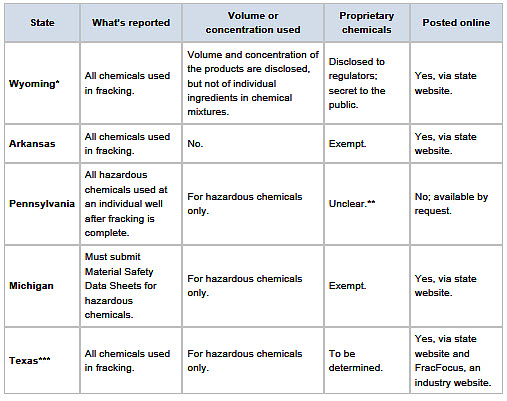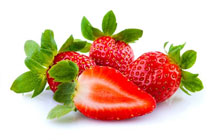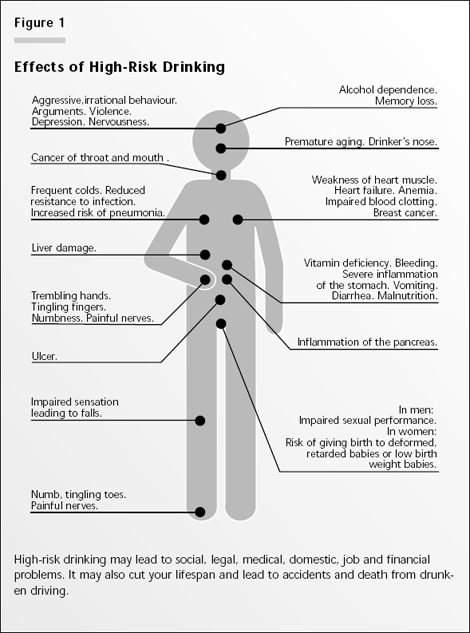The following information describes chemicals used in hydraulic fracturing, i.e., hydrofracking, and is included here as an addendum to the article: “The United States Should Do More To Promote Safe Energy Production Which Does Not Threaten Environmental and Public Health”:
Environmental and human health concerns associated with hydraulic fracturing include (3):
- Ground water and aquifer contamination
- Risks to air quality
- Migration of gases and hydraulic fracturing chemicals to the surface
- Risk of explosive gases entering private potable water wells, creating “flammable water”
- Tremors and earthquakes within surrounding geographic areas
- Potential mishandling of waste
- Loss of land safe for agricultural production
- Loss of land value
- Human and animal health risks, including, but not limited to: birth defects, miscarriages, cancers, attention deficit disorder, hyperactivity, learning and other neurological deficits and/or damage. Chemicals currently being used to drill natural gas wells in Pennsylvania have already been associated with neurological problems.
A 2010 study performed by the Environmental Protection Agency (EPA) found contaminants in drinking water including: arsenic, copper, vanadium, and adamantanes adjacent to drilling operations. The EPA has investigated several sources, including agricultural activity, but noted gas drilling as a potential cause. On June 23, 2011, the EPA announced that it will examine claims of water pollution related to hydraulic fracturing in Texas, North Dakota, Pennsylvania, Colorado and Louisiana (3).“
Chart: States With Drilling Disclosure Rules (8)
** Pennsylvania officials did not return calls or emails seeking clarification.
*** The Texas legislature passed the law in May 2011, but state regulators have until 2013 to complete the actual rules.
Chemical Constituents in Additives (3)
About 750 chemicals have been listed as additives for hydraulic fracturing in a report to the US Congress in 2011 (5). The following is a list of the different types of additives that are used in fracturing operations, as indicated by the New York State Department of Environmental Conservation (7).
Classes of Additives |
Purpose |
Examples |
|---|---|---|
| Acid | Facilitates entry into rock formations | hydrochloric acid |
| Biocides | Kill bacteria and reduce risk of fouling | glutaraldehyde, 2,2 Dibromo-3-nitrilopropionamide |
| Breaker | Facilitate proppant entry | peroxodisulfates |
| Clay stabilizer | Clay stabilization | salts, ie tetramethylammonium chloride |
| Corrosion inhibitor | Well maintenance | methanol |
| Crosslinker | Facilitate proppant entry | potassium hydroxide |
| Friction reducers | Improve surface pressure | sodium acrylate, polyacrylamide |
| Gelling agents | Proppant placement | guar gum |
| Iron control | Well maintenance | citric acid, thioglycolic acid |
| Scale inhibitor | Prevention of precipitation | ammonium chloride, ethylene glycol, polyaccrylate |
| Surfactant | Reduction in fluid tension | methanol, isopropanol |
List of Additives for Hydraulic Fracturing (6)
About 750 chemicals have been listed as additives for hydraulic fracturing in a report to the US Congress in 2011 (5). The following is a partial list of the chemical constituents in additives used in fracturing operations, as indicated by the New York State Department of Environmental Conservation (7).
CAS Number |
Chemical Constituent |
|---|---|
| 2634-33-5 | 1,2-Benzisothiazolin-2-one / 1,2-benzisothiazolin-3-one |
| 95-63-6 | 1,2,4-trimethylbenzene |
| 123-91-1 | 1,4-Dioxane |
| 3452-07-1 | 1-eicosene |
| 629-73-2 | 1-hexadecene |
| 112-88-9 | 1-octadecene |
| 1120-36-1 | 1-tetradecene |
| 10222-01-2 | 2,2 Dibromo-3-nitrilopropionamide, a biocide |
| 27776-21-2 | 2,2′-azobis-{2-(imidazlin-2-yl)propane}-dihydrochloride |
| 73003-80-2 | 2,2-Dibromomalonamide |
| 15214-89-8 | 2-Acrylamido-2-methylpropane sulphonic acid sodium salt polymer |
| 46830-22-2 | 2-acryloyloxyethyl(benzyl)dimethylammonium chloride |
| 52-51-7 | 2-Bromo-2-nitro-1,3-propanediol |
| 111-76-2 | 2-Butoxy ethanol |
| 1113-55-9 | 2-Dibromo-3-Nitriloprionamide (2-Monobromo-3-nitriilopropionamide) |
| 104-76-7 | 2-Ethyl Hexanol |
| 67-63-0 | 2-Propanol / Isopropyl Alcohol / Isopropanol / Propan-2-ol |
| 26062-79-3 | 2-Propen-1-aminium, N,N-dimethyl-N-2-propenyl-chloride, homopolymer |
| 9003-03-6 | 2-propenoic acid, homopolymer, ammonium salt |
| 25987-30-8 | 2-Propenoic acid, polymer with 2 p-propenamide, sodium salt / Copolymer of acrylamide and sodium acrylate |
| 71050-62-9 | 2-Propenoic acid, polymer with sodium phosphinate (1:1) |
| 66019-18-9 | 2-propenoic acid, telomer with sodium hydrogen sulfite |
| 107-19-7 | 2-Propyn-1-ol / Propargyl alcohol |
| 51229-78-8 | 3,5,7-Triaza-1-azoniatricyclo[3.3.1.13,7]decane, 1-(3-chloro-2-propenyl)-chloride, |
| 115-19-5 | 3-methyl-1-butyn-3-ol |
| 127087-87-0 | 4-Nonylphenol Polyethylene Glycol Ether Branched / Nonylphenol ethoxylated / Oxyalkylated Phenol |
| 64-19-7 | Acetic acid |
| 68442-62-6 | Acetic acid, hydroxy-, reaction products with triethanolamine |
| 108-24-7 | Acetic Anhydride |
| 67-64-1 | Acetone |
| 79-06-1 | Acrylamide |
| 38193-60-1 | Acrylamide – sodium 2-acrylamido-2-methylpropane sulfonate copolymer |
| 25085-02-3 | Acrylamide – Sodium Acrylate Copolymer or Anionic Polyacrylamide |
| 69418-26-4 | Acrylamide polymer with N,N,N-trimethyl-2[1-oxo-2-propenyl]oxy Ethanaminium chloride |
| 15085 | -02-3 Acrylamide-sodium acrylate copolymer |
| 68551-12-2 | Alcohols, C12-C16, Ethoxylated (a.k.a. Ethoxylated alcohol) |
| 64742-47-8 | Aliphatic Hydrocarbon / Hydrotreated light distillate / Petroleum Distillates / Isoparaffinic Solvent / Paraffin Solvent / Napthenic Solvent |
| 64743-02-8 | Alkenes |
| 68439-57-6 | Alkyl (C14-C16) olefin sulfonate, sodium salt |
| 9016-45-9 | Alkylphenol ethoxylate surfactants |
| 1327-41-9 | Aluminum chloride |
| 73138-27-9 | Amines, C12-14-tert-alkyl, ethoxylated |
| 71011-04-6 | Amines, Ditallow alkyl, ethoxylated |
| 68551-33-7 | Amines, tallow alkyl, ethoxylated, acetates |
| 1336-21-6 | Ammonia |
| 631-61-8 | Ammonium acetate |
| 68037-05-8 | Ammonium Alcohol Ether Sulfate |
| 7783-20-2 | Ammonium bisulfate |
| 10192-30-0 | Ammonium bisulfite |
| 12125-02-9 | Ammonium chloride |
| 7632-50-0 | Ammonium citrate |
| 37475-88-0 | Ammonium Cumene Sulfonate |
| 1341-49-7 | Ammonium hydrogen-difluoride |
| 6484-52-2 | Ammonium nitrate |
| 7727-54-0 | Ammonium Persulfate / Diammonium peroxidisulphate |
| 1762-95-4 | Ammonium Thiocyanate |
| 7664-41-7 | Aqueous ammonia |
| 121888-68-4 | Bentonite, benzyl(hydrogenated tallow alkyl) dimethylammonium stearate complex / organophilic clay |
| 71-43-2 | Benzene |
| 119345-04-9 | Benzene, 1,1′-oxybis, tetratpropylene derivatives, sulfonated, sodium salts |
| 74153-51-8 | Benzenemethanaminium, N,N-dimethyl-N-[2-[(1-oxo-2-propenyl)oxy]ethyl]-, chloride, polymer with 2-propenamide |
| 10043-35-3 | Boric acid |
| 1303-86-2 | Boric oxide / Boric Anhydride |
| 71-36-3 | Butan-1-ol |
| 68002-97-1 | C10 – C16 Ethoxylated Alcohol |
| 68131-39-5 | C12-15 Alcohol, Ethoxylated |
| 10043-52-4 | Calcium chloride |
| 124-38-9 | Carbon dioxide |
| 68130-15-4 | Carboxymethylhydroxypropyl guar |
| 9012-54-8 | Cellulase / Hemicellulase Enzyme |
| 9004-34-6 | Cellulose |
| 10049-04-4 | Chlorine dioxide |
| 77-92-9 | Citric Acid |
| 94266-47-4 | Citrus Terpenes |
| 61789-40-0 | Cocamidopropyl betaine |
| 68155-09-9 | Cocamidopropylamine Oxide |
| 68424-94-2 | Coco-betaine |
| 7758-98-7 | Copper(II) sulfate |
| 31726-34-8 | Crissanol A-55 |
| 14808-60-7 | Crystalline Silica (Quartz) |
| 7447-39-4 | Cupric chloride dihydrate |
| 1120-24-7 | Decyldimethyl Amine |
| 2605-79-0 | Decyl-dimethyl Amine Oxide |
| 3252-43-5 | Dibromoacetonitrile |
| 25340-17-4 | Diethylbenzene |
| 111-46-6 | Diethylene glycol |
| 22042-96-2 | Diethylenetriamine penta (methylenephonic acid) sodium salt |
| 28757-00-8 | Diisopropyl naphthalenesulfonic acid |
| 68607-28-3 | Dimethylcocoamine, bis(chloroethyl) ether, diquaternary ammonium salt |
| 7398-69-8 | Dimethyldiallylammonium chloride |
| 25265-71-8 | Dipropylene glycol |
| 139-33-3 | Disodium Ethylene Diamine Tetra Acetate |
| 5989-27-5 | D-Limonene |
| 123-01-3 | Dodecylbenzene |
| 27176-87-0 | Dodecylbenzene sulfonic acid |
| 42504-46-1 | Dodecylbenzenesulfonate isopropanolamine |
| 50-70-4 | D-Sorbitol / Sorbitol |
| 37288-54-3 | Endo-1,4-beta-mannanase, or Hemicellulase |
| 149879-98-1 | Erucic Amidopropyl Dimethyl Betaine |
| 89-65-6 | Erythorbic acid, anhydrous |
| 54076-97-0 | Ethanaminium, N,N,N-trimethyl-2-[(1-oxo-2-propenyl)oxy]-, chloride, homopolymer |
| 107-21 | -1 Ethane-1,2-diol / Ethylene Glycol |
| 9002-93-1 | Ethoxylated 4-tert-octylphenol |
| 68439-50-9 | Ethoxylated alcohol |
| 126950-60-5 | Ethoxylated alcohol |
| 67254-71-1 | Ethoxylated alcohol (C10-12) |
| 68951-67-7 | Ethoxylated alcohol (C14-15) |
| 68439-46-3 | Ethoxylated alcohol (C9-11) |
| 66455-15-0 | Ethoxylated Alcohols |
| 84133-50-6 | Ethoxylated Alcohols (C12-14 Secondary) |
| 68439-51-0 | Ethoxylated Alcohols (C12-14) |
| 78330-21-9 | Ethoxylated branch alcohol |
| 34398-01-1 | Ethoxylated C11 alcohol |
| 61791-12-6 | Ethoxylated Castor Oil |
| 61791-29-5 | Ethoxylated fatty acid, coco |
| 61791-08-0 | Ethoxylated fatty acid, coco, reaction product with ethanolamine |
| 68439-45-2 | Ethoxylated hexanol |
| 9036-19-5 | Ethoxylated octylphenol |
| 9005-67-8 | Ethoxylated Sorbitan Monostearate |
| 9004-70-3 | Ethoxylated Sorbitan Trioleate |
| 64-17-5 | Ethyl alcohol / ethanol |
| 100-41-4 | Ethyl Benzene |
| 97-64-3 | Ethyl lactate |
| 9003-11-6 | Ethylene Glycol-Propylene Glycol Copolymer (Oxirane, methyl-, polymer with oxirane) |
| 75-21-8 | Ethylene oxide |
| 5877-42-9 | Ethyloctynol |
| 68526-86-3 | Exxal 13 |
| 61790-12-3 | Fatty Acids |
| 68188-40-9 | Fatty acids, tall oil reaction products w/ acetophenone, formaldehyde & thiourea |
| 9043-30-5 | Fatty alcohol polyglycol ether surfactant |
| 7705-08-0 | Ferric chloride |
| 7782-63-0 | Ferrous sulfate, heptahydrate |
| 50-00-0 | Formaldehyde |
| 29316-47-0 | Formaldehyde polymer with 4,1,1-dimethylethyl phenolmethyl oxirane |
| 153795-76-7 | Formaldehyde, polymers with branched 4-nonylphenol, ethylene oxide and propylene oxide |
| 75-12-7 | Formamide |
| 64-18-6 | Formic acid |
| 110-17-8 | Fumaric acid |
| 65997-17-3 | Glassy calcium magnesium phosphate |
| 111-30-8 | Glutaraldehyde |
| 56-81-5 | Glycerol / glycerine |
| 9000-30-0 | Guar Gum |
| 64742-94-5 | Heavy aromatic petroleum naphtha |
| 9025-56-3 | Hemicellulase |
| 7647-01-0 | Hydrochloric Acid / Hydrogen Chloride / muriatic acid |
| 7722-84-1 | Hydrogen peroxide |
| 79-14-1 | Hydroxy acetic acid |
| 35249-89-9 | Hydroxyacetic acid ammonium salt |
| 9004-62-0 | Hydroxyethyl cellulose |
| 5470-11-1 | Hydroxylamine hydrochloride |
| 39421-75-5 | Hydroxypropyl guar |
| 35674-56-7 | Isomeric Aromatic Ammonium Salt |
| 64742-88-7 | Isoparaffinic Petroleum Hydrocarbons, Synthetic |
| 64-63-0 | Isopropanol |
| 98-82-8 | Isopropylbenzene (cumene) |
| 68909-80-8 | Isoquinoline, reaction products with benzyl chloride and quinoline |
| 8008-20-6 | Kerosene |
| 64742-81-0 | Kerosine, hydrodesulfurized |
| 63-42-3 | Lactose |
| 64742-95-6 | Light aromatic solvent naphtha |
| 1120-21-4 | Light Paraffin Oil |
| 14807-96-6 | Magnesium Silicate Hydrate (Talc) |
| 1184-78-7 | methanamine, N,N-dimethyl-, N-oxide |
| 67-56-1 | Methanol |
| 68891-11-2 | Methyloxirane polymer with oxirane, mono (nonylphenol) ether, branched |
| 8052-41-3 | Mineral spirits / Stoddard Solvent |
| 141-43-5 | Monoethanolamine |
| 44992-01-0 | N,N,N-trimethyl-2[1-oxo-2-propenyl]oxy Ethanaminium chloride |
| 64742-48-9 | Naphtha (petroleum), hydrotreated heavy |
| 91-20-3 | Naphthalene |
| 38640-62-9 | Naphthalene bis(1-methylethyl) |
| 93-18-5 | Naphthalene, 2-ethoxy- |
| 68909-18-2 | N-benzyl-alkyl-pyridinium chloride |
| 68139-30-0 | N-Cocoamidopropyl-N,N-dimethyl-N-2-hydroxypropylsulfobetaine |
| 7727-37-9 | Nitrogen, Liquid form |
| 68412-54-4 | Nonylphenol Polyethoxylate |
| 121888-66-2 | Organophilic Clays |
| 64742-65-0 | Petroleum Base Oil |
| 64741-68-0 | Petroleum naphtha |
| 70714-66-8 | Phosphonic acid, [[(phosphonomethyl)imino]bis[2,1-ethanediylnitrilobis(methylene)]]tetrakis-, ammonium salt |
| 8000-41-7 | Pine Oil |
| 60828-78-6 | Poly(oxy-1,2-ethanediyl), a-[3,5-dimethyl-1-(2-methylpropyl)hexyl]-w-hydroxy- |
| 25322-68-3 | Poly(oxy-1,2-ethanediyl), a-hydro-w-hydroxy / Polyethylene Glycol |
| 24938-91-8 | Poly(oxy-1,2-ethanediyl), α-tridecyl-ω-hydroxy- |
| 51838-31-4 | Polyepichlorohydrin, trimethylamine quaternized |
| 56449-46-8 | Polyethlene glycol oleate ester |
| 62649-23-4 | Polymer with 2-propenoic acid and sodium 2-propenoate |
| 9005-65-6 | Polyoxyethylene Sorbitan Monooleate |
| 61791-26-2 | Polyoxylated fatty amine salt |
| 127-08-2 | Potassium acetate |
| 12712-38-8 | Potassium borate |
| 1332-77-0 | Potassium borate |
| 20786-60-1 | Potassium Borate |
| 584-08-7 | Potassium carbonate |
| 7447-40-7 | Potassium chloride |
| 590-29-4 | Potassium formate |
| 1310-58-3 | Potassium Hydroxide |
| 13709-94-9 | Potassium metaborate |
| 24634-61-5 | Potassium sorbate |
| 112926-00-8 | Precipitated silica / silica gel |
| 57-55-6 | Propane-1,2-diol, or Propylene glycol |
| 107-98-2 | Propylene glycol monomethyl ether |
| 68953-58-2 | Quaternary Ammonium Compounds |
| 62763-89-7 | Quinoline,2-methyl-, hydrochloride |
| 15619-48-4 | Quinolinium, 1-(phenylmethl),chloride |
| 7631-86-9 | Silica, Dissolved |
| 5324-84-5 | Sodium 1-octanesulfonate |
| 127-09-3 | Sodium acetate |
| 95371-16-7 | Sodium Alpha-olefin Sulfonate |
| 532-32-1 | Sodium benzoate |
| 144-55-8 | Sodium bicarbonate |
| 7631-90-5 | Sodium bisulfate |
| 7647-15-6 | Sodium bromide |
| 497-19-8 | Sodium carbonate |
| 7647-14-5 | Sodium Chloride |
| 7758-19-2 | Sodium chlorite |
| 3926-62-3 | Sodium chloroacetate |
| 68-04-2 | Sodium citrate |
| 6381-77-7 | Sodium erythorbate / isoascorbic acid, sodium salt |
| 2836-32-0 | Sodium Glycolate |
| 1310-73-2 | Sodium Hydroxide |
| 7681-52-9 | Sodium hypochlorite |
| 7775-19-1 | Sodium Metaborate .8H2O |
| 10486-00-7 | Sodium perborate tetrahydrate |
| 7775-27-1 | Sodium persulfate |
| 9003-04-7 | Sodium polyacrylate |
| 7757-82-6 | Sodium sulfate |
| 1303-96-4 | Sodium tetraborate decahydrate |
| 7772-98-7 | Sodium thiosulfate |
| 1338-43-8 | Sorbitan Monooleate |
| 57-50-1 | Sucrose |
| 5329-14-6 | Sulfamic acid |
| 112945-52-5 | Synthetic Amorphous / Pyrogenic Silica / Amorphous Silica |
| 68155-20-4 | Tall Oil Fatty Acid Diethanolamine |
| 8052-48-0 | Tallow fatty acids sodium salt |
| 72480-70-7 | Tar bases, quinoline derivs., benzyl chloride-quaternized |
| 68647-72-3 | Terpene and terpenoids |
| 68956-56-9 | Terpene hydrocarbon byproducts |
| 533-74-4 | Tetrahydro-3,5-dimethyl-2H-1,3,5-thiadiazine-2-thione (a.k.a. Dazomet) |
| 55566-30-8 | Tetrakis(hydroxymethyl)phosphonium sulfate (THPS) |
| 75-57-0 | Tetramethyl ammonium chloride |
| 64-02-8 | Tetrasodium Ethylenediaminetetraacetate |
| 68-11-1 | Thioglycolic acid |
| 62-56-6 | Thiourea |
| 68527-49-1 | Thiourea, polymer with formaldehyde and 1-phenylethanone |
| 108-88-3 | Toluene |
| 81741-28-8 | Tributyl tetradecyl phosphonium chloride |
| 68299-02-5 | Triethanolamine hydroxyacetate |
| 112-27-6 | Triethylene glycol |
| 52624-57-4 | Trimethylolpropane, Ethoxylated, Propoxylated |
| 150-38-9 | Trisodium Ethylenediaminetetraacetate |
| 5064-31-3 | Trisodium Nitrilotriacetate |
| 7601-54-9 | Trisodium orthophosphate |
| 57-13-6 | Urea |
| 25038-72-6 | Vinylidene Chloride/Methylacrylate Copolymer |
| 7732-18-5 | Water |
| 1330-20-7 | Xylene |
| Aliphatic acids | |
| Aliphatic alcohol glycol ether | |
| Alkyl Aryl Polyethoxy Ethanol | |
| Alkylaryl Sulfonate | |
| Aromatic hydrocarbons | |
| Aromatic ketones | |
| Oxyalkylated alkylphenol | |
| Petroleum distillate blend | |
| Polyethoxylated alkanol | |
| Polymeric Hydrocarbons | |
| Salt of amine-carbonyl condensate | |
| Salt of fatty acid/polyamine reaction product | |
| Sugar | |
| Surfactant blend |
References:
- Burkey, Brent M. “See the State’s List of Chemicals Used in Hydrofracking.” July 19, 2010. ( www.yorkblog.com/…/see-the-states-list-of-chemicals-used-in-hydr…)
- Hydrofracking Can Leach Toxic Chemicals. Are You Safe? (www.nrdc.org)
- “Hydraulic Fracturing.” Wikipedia: The Free Encyclopedia. July 21, 2011. (en.wikipedia.org/wiki/Hydraulic_fracturing)
- Kuznetz, Nicholas. “Critics Find Gaps in State Laws to Disclose Hydrofracking Chemicals.” ProPublica. June 20, 2011.(www.propublica.org/article/…hydrofracking chemicals-single)
- Kusnetz, Nicholas. “Fracking Chemicals Cited in Congressional Report Stay Underground”. ProPublica. Published April 8, 2011. Retrieved July 11, 2011.
- “List of Additives for Hydraulic Fracturing.” Wikipedia: The Free Encyclopedia. July 27, 2011. (en.wikipedia.org/wiki/List-of-additives-for-hydraulic -fracturing)
- “Natural Gas Development Activities and High-Volume Hydraulic Fracturing”. New York State Department of Environmental Conservation. September 30, 2009. pp. 45–51.
- “States With Drilling Disclosure Rules”. WTFrack.org: Chart: States With Drilling Disclosure Rules”. June 24, 2011. <strong>Source:</strong> <em>Reporting by Nicholas Kusnetz/ProPublica</em> (wtfrackorg.blogspot.com/…/chart-states-with-drilling-disclosure.html)
- http://anga.us/media/136662/cogis%20complaint%20report%205-23-08.pdf
- “EPA: Natural Gas Drilling May Contaminate Drinking Water – Science News”. redOrbit. 2011-06-25. Retrieved 2011-07-13.
{ Comments on this entry are closed }



























































